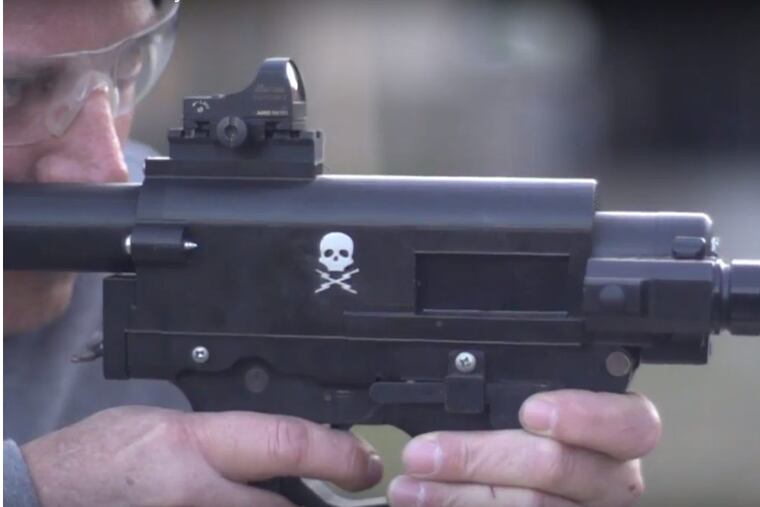3D-printed guns not a big threat, say those who’ve tried it
The printers are used to make jewelry, toys, and even surgical aids. But guns? Criminals are likely to take an easier route.

With heated nozzles that travel back and forth, depositing layer after layer of plastic in any shape imaginable, 3D printers are hailed as a high-tech tool for the masses.
Craft-minded folks have used them for decades, creating jewelry, toys, and action figures. Home-repair buffs fashion replacement brackets for refrigerator shelves. Paleontologists make models of dinosaur bones, and surgeons print out full-size replicas of human organs, allowing them to plan a difficult operation.
And yes, the printers also can be used to make guns.
But despite the public outcry and legal wrangling over a Texas nonprofit that sought to distribute instructions to print firearms, those who have used the technology say it poses little threat to public safety.
Darren Booth, a gun designer who lives outside Huntington, W.Va., said it takes him 30 hours to print out the plastic parts for an AR-style 9mm pistol that he devised, plus another five hours of assembly and fine-tuning. While most of the gun is printed in plastic, a few parts — notably the barrel, which must withstand a high degree of stress during firing — are made of metal.
"It's not just 'click print' and it pops out the other side," Booth said.
A criminal, he predicted, would likely take an easier route. Guns are easy to come by in the United States, through various legal and illegal means. And if a person with bad intentions truly wanted to make his own firearm — to avoid traceability by the government, say — there are easier, faster, and cheaper ways to do that, too. Parts can be ordered, finished, and assembled by someone with know-how, Booth and other gun enthusiasts say.
>> READ MORE: I bought an AR-15 semiautomatic rifle in Philly in 7 minutes
"They're making a big deal out of nothing," Booth said of those who warn about 3D-printed firearms.
Jeff Rodriguez, a gun designer who lives outside Seattle, said advanced expertise is required to turn the computer files into a firearm.
"Model gun files won't make you a gunsmith any more than scrolls for a player piano will make you a pianist," he said.
Yet other experts in 3D-printing technology see a possible cause for concern.
Evan Malone, founder and president of NextFab — a Philadelphia-based network of workshops stocked with 3D-printers and other tools — agreed that there are easier ways to make untraceable firearms. But he is concerned that advances in 3D printing might put the idea into the heads of those outside the gun-owning community.
"It would be a new population that doesn't necessarily have that background and maybe doesn't have the appreciation or concern about legal gun ownership or the potential injury to themselves and others," Malone said. "They don't necessarily have the background a gunsmith would have, in terms of awareness of how materials behave and the best ways to do it."
On Tuesday, a federal judge in Seattle issued a temporary restraining order to stop the release of instructions to make 3D-printed plastic guns. The company behind the plans, Austin, Texas-based Defense Distributed, had reached a settlement with the federal government in June allowing it to make the plans for the guns available for download on Wednesday.
The White House on Wednesday said the Justice Department had not consulted President Trump about the settlement. White House press secretary Sarah Huckabee Sanders said the Justice Department "made a deal without the president's approval."
Trump has questioned whether his administration should have agreed to allow the plans to be posted online.
Though 3D printers have been around since the early 1980s, they became a widespread tool in the past 15 years with the advent of open-source online blueprints — enabling tech-savvy people to make their own printers.
Open access also is the mantra for the computerized instructions that are used to print out objects. These are essentially long lists of coordinates — telling the printer to move left, right, forward, backward, up, and down as it deposits minute amounts of heated plastic. High-end commercial models also can print objects in metal, but they cost $100,000 to $1 million or more, Malone said.
Among the concerns about printed firearms is that they are made from plastic, potentially enabling owners to sneak them through a metal detector.
In theory, that is possible. But airports now widely use "millimeter-wave" detectors, which allow the operator to scan for objects by shape, not by whether they contain metal. And even in other facilities that rely on metal detectors, those devices would pick up metal bullets.
Law enforcement sources were reluctant to comment on the potential threat posed by 3D-printed firearms. The International Association of Chiefs of Police did not reply to a request for comment. The Philadelphia Police Department also declined to weigh in on the topic, but City Council has done so. In November 2013, Council members passed a bill banning the use of 3D printers to make firearms, which was signed into law the next month by Mayor Michael Nutter.
The whole discussion rankles many in the gun community, who like to point out that most people who own firearms never commit a crime.
So if printing out parts for firearms is so difficult and time-consuming, why do it?
Booth, the West Virginia firearm designer, sounds like anyone else in the 3D-printing community when asked that question. It's a creative outlet.
"It's mainly the novelty," he said. "Just trying out new designs."
This article contains information from the Associated Press.